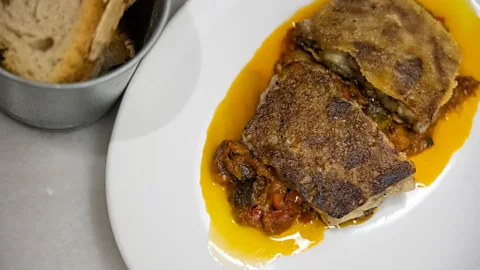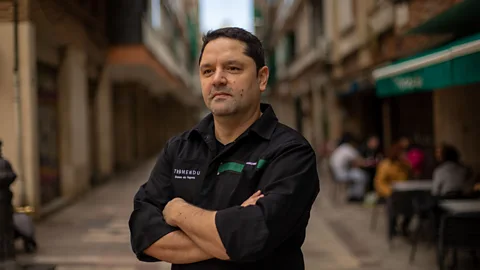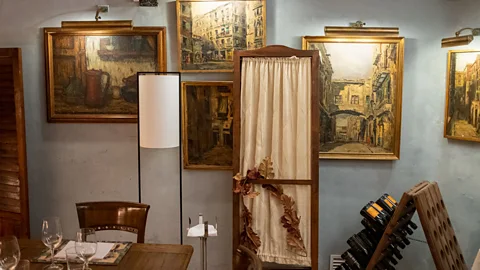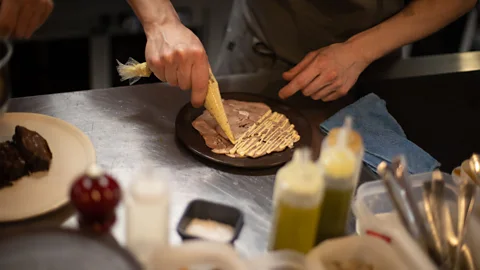The five best places to eat Catalan food in Barcelona
 Sergi RuGrand
Sergi RuGrandFrom La Pubilla to Tramendu to Agut Avinyó, here are a local food journalist's recommendations of the best places to eat in the Catalan capital.
The proud capital of Catalonia, Barcelona not only has own independent-minded identity and language, but also boasts its own unique cuisine. Located in Spain's north-east corner, the triangular-shaped autonomous community has long drawn influences from those it borders: the Mediterranean to the east, the Pyrenees mountains and France to the north and the rest of Spain to the west.
"In the Iberian Peninsula, three main ways of preparing food predominate. The south cuisine relies mostly on frying the ingredients, the north cuisine revolves around stewing and the regions in the centre of Spain tend to roast meat," said Marc Casanovas, a Barcelona-based food journalist and the author of No Soy Uno de los Vuestros, about a Catalan chef. "In Catalonia, a highly industrial region, slowly stewing xup-xup, referring to the noise of slow-cooked recipes, is key."
As Casanovas explained, "the harbours along the coast have traditionally brought exotic cuisine [to] Barcelona more than other regions of Spain" and seafood has historically been considered "nobler" than meat. These ingredients are often fused together in a slow simmer, with aubergines and tomatoes from the Llobregat river valley stewed alongside lobster or pork in a mar i muntanya (surf and turf) medley.
Today, if you push beyond the pre-prepared paella (which is better in Valencia) and sangria, visitors to Catalonia's undisputed culinary capital will find dishes found nowhere else in Spain, like "fork breakfasts", beef slow cooked in chocolate, grilled frog or spicy snails.
Here are five of Casanovas' favourite places to eat.
 Sergi RuGrand
Sergi RuGrand1. La Pubilla
Owner Alexis Peñalver was born and raised in the Pyrenees, where his grandmother used to cook meat for breakfast – an incredibly filling meal that Catalans call esmorzar de forquilla ("fork breakfast"). After working as a line cook for years elsewhere in Spain and abroad, in 2008 he opened La Pubilla, a name typically given to the eldest daughter in Catalan families. Today, the small restaurant in Barcelona's bustling Gràcia neighbourhood serves traditional Catalan dishes such as aubergine carpaccio and bacallà (dried, salted cod with pine nuts), though it's best known for its esmorzar de forquilla varieties.
Catalans typically go for "fork breakfasts" at about 09:00. The tradition originated in the late 19th Century when factories and mines spread across Catalonia and workers needed a strong protein meal early in the day. Though La Pubilla is open all day, Casanovas recommends showing up around 09:00 and pairing your fork breakfast with samfaina (a kind of Catalan ratatouille).
Casanovas and I ordered stewed pork feet with a fried egg on top, which we watered down with a glass of strong red wine and accompanied by pa amb tomàquet, the classic Catalan way to eat bread with some garlic, a gently squeezed tomato and olive oil on top.
Even as Barcelona grapples with overtourism, La Pubilla remains a largely locals-only joint. It serves the kind of food – such as fricandó (beef stewed with chocolate, onion and red wine) and rice mar i muntanya (combining fish, seafood and vegetables) – that food journalists like Casanovas have begun referring to as "situated cuisine", meaning deeply rooted in place and tradition.
Website: https://www.catalunya.com/la-pubilla-17-14001-497514?language=en
Neighbourhood: Gràcia
Address: 23 Llibertat Square
Phone number: +34 932 18 29 94
Instagram: @lapubillagracia
 Sergi RuGrand
Sergi RuGrand2. Tramendu Bar
Owner Jordi Marzo was born in Sants, a working-class Barcelona neighbourhood. After working alongside Michelin-starred chef Nandu Jubany at Petit Comitè, Marzo returned to Sants to open two restaurants next to each other, each bearing Marzo's childhood nickname: Tramendu Ignite Els Fogons, a traditional restaurant, and a smaller tapas bar called Tramendu Vermuting.
If you order one thing, what should it be?
"I'd say the cuttlefish and beef meatballs platillo (small plate)" – Marzo
Both Tramendus were both inspired by the Sunday meals Marzo's mother, used to prepare for the family when he was a child, and like La Pubilla, they're true locals-only spots – in part due to their location near the out-of-the-way L'Hospitalet area. Regulars huddle around Tramendu Vermuting's long marble bar and on its terrace to eatRussian salad, capipota (pork head and feet seasoned meat), calamari with tomato sauce and olives of all shapes and sizes with hot Espinaler sauce.
Casanovas recommends trying a small dish of stewed spicy snails on a visit to Tramendu bar; the Catalan specialty has a texture similar to that of mushrooms and pork feet.
Website: https://www.bcnrestaurantes.com/barcelona.asp?restaurante=tramendu
Neighbourhood: Sants
Address: 8 Passatge d'Andalusia
Phone number: +34 931 629 176
Instagram: @tramendubar
 Sergi RuGrand
Sergi RuGrand3. La Cova Fumada
La Cova Fumada opened in 1944 in La Barceloneta, the city's historical fishing neighbourhood. Its name means "the smoky cave", and it recalls the days when the walls were stained black from the fumes of its old kitchen. Today, the restaurant is owned by Josep Maria Solé Fresquet and his family.
Josep's grandmother, Maria, opened La Cova Fumada with her husband when they came to Barcelona from rural Tortosa in the south of Catalonia. At first, they only served coffee and sailors used to bring their own breakfast. "Pretty soon other restaurants run by Spanish migrants coming from post-war impoverished areas like Murcia and Andalucía spread across the city, introducing an as-yet-unknown tradition in Catalonia: the Spanish tapas(small plates that would tapar (cover) the drink to avoid insects from drowning on it)," said Josep.
To emulate Spain's increasingly popular and profitable tapas, Maria created the bomba, a meat-and-potato croquette with a spicy sauce with hints of mustard and tomato that's a well-kept family secret.
How Catalan cuisine has changed
"When we study Catalan cuisine, we see a divide in time: we're talking about a cuisine that up until the 1920s was highly influenced by France but which, after the Spanish Civil War, turned to slowly cooked stews with few products. If we compare the Catalan corpus with the Spanish recipes we might find some similarities, but there's no doubt Catalan cuisine has a distinct identity." – Casanovas
When Casanovas and I visited, next to an array of bombas was a pile of tempting artichokes covered with red pepper powder, another speciality. True to the neighbourhood's roots, there is always a range of fresh fish on hand, including sardines, mackerel, shrimps, prawns and octopus, with Josep buying his fish directly from La Barceloneta's last three fishermen.
"This is a place to have a full lunch, not just drinks and a few bites," Josep said. Just be sure to get here early – the restaurant closes at 15:30 or whenever the food runs out.
Website: https://www.lacovafumada.com/
Neighbourhood: La Barceloneta
Address: Carrer del Baluard 56
Phone number: +34 935 16 73 02
Instagram: @la_cova_fumada
 Sergi RuGrand
Sergi RuGrand4. Ca l'Agut
Ca l'Agut is a symbol of Barcelona. The restaurant is located in Carrer Avinyó, one of the oldest and most stylish streets in Barcelona's Gothic neighbourhood, dating to the Romans. Due to its location just a few steps away from the City Council and the headquarters of the Catalan autonomous government, Ca l’Agut is famous for serving many Catalan politicians over the years, from Franco-era loyalists to Barcelona's current mayor Ada Colau. According to Jordi Castellví, the former third-generation owner, they're specialists in "honest, simple, high-quality [food] at a low cost".
Ca l’Agut's first chef was Castellví's grandmother, who came from rural Cardona in the heart of Catalonia. She used to cook mainly offal dishes, including fried cow brain. Castellví, 64, explained that his generation still associates such dishes with their childhoods and their mothers, who would prepare it for them. While offal isn't nearly as common in Catalonia as it once was, you can still find it at Agut alongside more traditional dishes like grilled frog with garlic or stewed mountain rice with black pork sausage – Casanovas' favourite.
Castellví explained that the restaurant used to host sailors and peasants staying the night. "In the 1960s, some artists would give their paintings in exchange of food; some others gave them to us just as a sign of friendship." Today, the restaurant's wine cellar and walls resemble an art gallery. Casanovas recommends coming in the late afternoon, snagging one of the dark wooden tables under the many oversized paintings on the wall and ordering off the lunch menu.
Website: https://www.barcelona.com/barcelona_directory/restaurants/catalan/agut
Address: 16 Gignàs street
Phone number: +34 933 151 709
Instagram: @restaurantcalagut
 Sergi RuGrand
Sergi RuGrand5. Suru Bar
Suru Bar opened in February 2021 in front of the Mercat del Ninot, the market where Casanovas grew up. There is no sign outside, but if you push open an unmarked door, you'll find stone tables distributed around an open kitchen with bright red walls and a soaring ceiling. The restaurant's manager, Gemma López, explained that the restaurant sources its ingredients from the Mercat del Ninot, but unlike other typical Catalan lunch spots nearby, Suru takes its locally grown ingredients in a different direction.
Suru Bar is influenced by Japanese food and its short menu changes regularly, depending on the season and chef Charlie Morote's will. When we came, Morote was trying new recipes inspired by yakitoris (Japanese chicken skewers). "We divide the chicken into different parts, like the wings or the legs, but the Japanese divide it into even smaller parts. Charlie cooks chicken tonsils skews and chicken skin skewers, for instance," López said.
Casanovas recommends ordering about six different small dishes per two people, and said Suru's food pairs well with their natural wines. Despite its Japanese-leaning menu, Casanovas insists Suru is decidedly Catalan in spirit. "There's nothing more local than platillos – food served in small dishes containing meat and vegetables and legumes," he said. "Besides, there is the chicken nostrils, the entrails of the animals are a key part of the local traditional recipes."
Website: https://bcnfoodieguide.com/suru-bar-sin-rotulo-y-con-personalidad/
Address: 134 Casanova
Phone number: +34 937 14 73 93
Instagram: @suru.bar
---
Join more than three million BBC Travel fans by liking us on Facebook, or follow us on Twitter and Instagram.
If you liked this story, sign up for the weekly bbc.com features newsletter called "The Essential List". A handpicked selection of stories from BBC Future, Culture, Worklife and Travel, delivered to your inbox every Friday.
